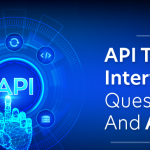Visual Basic (VB) is a versatile and widely-used programming language known for its simplicity and ease of use. Whether you’re a seasoned developer or aspiring to enter the field, preparing for a Visual Basic interview is crucial. In this comprehensive guide, we’ll cover the top 30 Visual Basic interview questions and provide detailed answers to help you ace your interview and showcase your proficiency in VB.
The requirements for Visual Basic development depend on the specific version and platform you’re using. However, here are some general requirements:
- Operating System: Visual Basic development can typically be done on Windows-based operating systems, such as Windows 10, Windows 8.1, or Windows 7.
- Development Environment: You’ll need an integrated development environment (IDE) to write, debug, and compile Visual Basic code. Microsoft offers Visual Studio as the primary IDE for Visual Basic development.
- Hardware Requirements: The hardware requirements vary depending on the version of Visual Studio you’re using and the size of your projects. Generally, a modern computer with sufficient RAM and processor speed is recommended.
- .NET Framework: Visual Basic is often used with the .NET Framework, so you may need to install the appropriate version of the .NET Framework on your development machine.
- Optional: Depending on your specific development needs, you may also require additional tools, libraries, or SDKs for tasks such as database access, web development, or integration with other platforms.
Visual Basic Interview Questions and Answers
What is Visual Basic?
Answer: Visual Basic is a programming language developed by Microsoft. It is designed to create Windows applications with a graphical user interface (GUI) quickly and easily.
What are the key features of Visual Basic?
Answer: Key features of Visual Basic include its simplicity, rapid application development (RAD) capabilities, event-driven programming model, and seamless integration with other Microsoft technologies.
Explain the difference between VB.NET and VB6.
Answer: VB.NET is the latest version of Visual Basic, based on the .NET framework, while VB6 refers to the earlier version of Visual Basic. VB.NET offers enhanced features, better performance, and improved language syntax compared to VB6.
What are the different data types in Visual Basic?
Answer: Visual Basic supports various data types, including Integer, String, Boolean, Date, Double, and Object, among others.
Describe the difference between ByVal and ByRef in Visual Basic.
Answer: ByVal passes arguments to a subroutine or function by value, meaning that changes made to the parameter within the subroutine do not affect the original value. ByRef, on the other hand, passes arguments by reference, allowing changes made within the subroutine to modify the original value.
How do you declare a variable in Visual Basic?
Answer: You can declare a variable in Visual Basic using the Dim keyword, followed by the variable name and optional data type.
What is the difference between Public, Private, and Protected access modifiers in Visual Basic?
Answer: Public variables and methods are accessible from any part of the program, Private variables and methods are accessible only within the same class or module, and Protected variables and methods are accessible within the same class or module and its derived classes.
Explain the concept of inheritance in Visual Basic.
Answer: Inheritance allows a class to inherit properties and methods from another class. It promotes code reusability and helps create a hierarchy of classes with shared functionality.
What is the purpose of the WithEvents keyword in Visual Basic?
Answer: The WithEvents keyword is used to declare an object variable that can respond to events raised by the referenced object. It is commonly used in event-driven programming to handle events such as button clicks or form submissions.
How do you handle exceptions in Visual Basic?
Answer: Exceptions in Visual Basic are handled using the Try…Catch…Finally blocks. Code that may raise an exception is enclosed within the Try block, and any exceptions are caught and handled in the Catch block. The Finally block is used to execute code that should always run, regardless of whether an exception occurs.
What is the purpose of the Me keyword in Visual Basic?
Answer: The Me keyword refers to the current instance of the class or object. It is often used within class methods to refer to the current object’s properties and methods.
How do you create a new instance of a class in Visual Basic?
Answer: You can create a new instance of a class in Visual Basic using the New keyword, followed by the class name and any required parameters.
Explain the difference between ByVal and ByRef parameters in Visual Basic.
Answer: ByVal parameters pass arguments to a subroutine or function by value, meaning that changes made to the parameter within the subroutine do not affect the original value. ByRef parameters pass arguments by reference, allowing changes made within the subroutine to modify the original value.
What is the difference between a function and a subroutine in Visual Basic?
Answer: A function returns a value to the calling code, while a subroutine does not return a value. Functions are declared using the Function keyword, while subroutines are declared using the Sub keyword.
How do you implement error handling in Visual Basic?
Answer: Error handling in Visual Basic is implemented using the Try…Catch…Finally blocks. Code that may raise an exception is enclosed within the Try block, and any exceptions are caught and handled in the Catch block. The Finally block is used to execute code that should always run, regardless of whether an exception occurs.
Explain the purpose of the Option Explicit statement in Visual Basic.
Answer: The Option Explicit statement forces explicit declaration of all variables in a module. It helps catch typographical errors and promotes code clarity by ensuring that all variables are declared before use.
What is the purpose of the Exit statement in Visual Basic?
Answer: The Exit statement is used to exit a loop or subroutine prematurely. It allows the program to skip the remaining code in the loop or subroutine and continue execution at the next statement following the loop or subroutine.
How do you handle arrays in Visual Basic?
Answer: Arrays in Visual Basic are declared using the Dim statement, followed by the array name and optional dimensions. Elements of an array are accessed using zero-based indexing, and arrays can be initialized using the Array initializer.
What is a collection in Visual Basic?
Answer: A collection in Visual Basic is a group of related objects. It provides a way to organize and manipulate multiple objects as a single entity, allowing for easier management and traversal of the objects.
Explain the concept of late binding in Visual Basic.
Answer: Late binding refers to the process of resolving object references and method calls at runtime rather than at compile time. It allows for greater flexibility and interoperability but may result in slower performance compared to early binding.
How do you handle events in Visual Basic?
Answer: Events in Visual Basic are handled using event handlers, which are methods that are executed in response to specific events raised by controls or objects. Event handlers are associated with events using the WithEvents keyword.
Describe the purpose of the WithEvents keyword in Visual Basic.
Answer: The WithEvents keyword is used to declare an object variable that can respond to events raised by the referenced object. It allows for dynamic event handling and is commonly used in event-driven programming scenarios.
What is the difference between an interface and a class in Visual Basic?
Answer: An interface defines a contract for classes to implement, specifying the properties and methods that must be provided by implementing classes. A class, on the other hand, is a blueprint for creating objects and can implement one or more interfaces.
How do you implement inheritance in Visual Basic?
Answer: Inheritance in Visual Basic is implemented using the Inherits keyword, which allows a class to inherit properties and methods from another class. Subclasses can then extend or override the functionality of the base class.
What is the purpose of the MyBase keyword in Visual Basic?
Answer: The MyBase keyword refers to the base class of the current class. It is often used to access members of the base class from within the subclass.
How do you handle null values in Visual Basic?
Answer: Null values in Visual Basic are represented by the Nothing keyword. You can check for null values using the IsNothing function or the Is operator.
What is the purpose of the ToString method in Visual Basic?
Answer: The ToString method is used to convert an object to its string representation. It is commonly overridden in custom classes to provide meaningful string representations of objects.
How do you implement multithreading in Visual Basic?
Answer: Multithreading in Visual Basic is implemented using the System.Threading namespace, which provides classes and interfaces for creating and managing threads. You can create new threads using the Thread class and control thread execution using synchronization mechanisms such as locks and mutexes.
Explain the concept of polymorphism in Visual Basic.
Answer: Polymorphism allows objects of different classes to be treated interchangeably based on their common interface or base class. It promotes code reuse and flexibility by allowing methods to be called on objects without knowing their specific type.
How do you handle exceptions in Visual Basic?
Answer: Exceptions in Visual Basic are handled using the Try…Catch…Finally blocks. Code that may raise an exception is enclosed within the Try block, and any exceptions are caught and handled in the Catch block. The Finally block is used to execute code that should always run, regardless of whether an exception occurs.
To explore more visit Visual Basic Documentation
Conclusion:
Preparing for a Visual Basic interview can be daunting, but with thorough preparation and a solid understanding of the language’s fundamentals, you can confidently tackle any interview question. By familiarizing yourself with these top 30 Visual Basic interview questions and their answers, you’ll be well-equipped to showcase your skills and expertise in Visual Basic programming.








